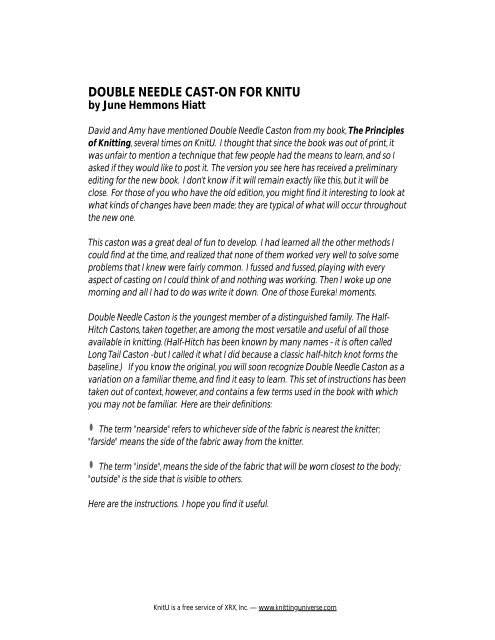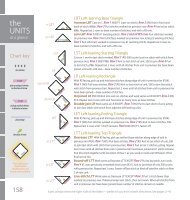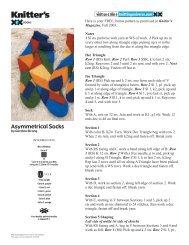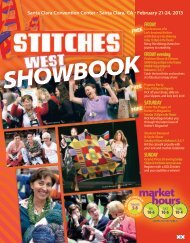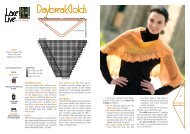Double Needle Cast-On - Knitting Universe
Double Needle Cast-On - Knitting Universe
Double Needle Cast-On - Knitting Universe
- No tags were found...
Create successful ePaper yourself
Turn your PDF publications into a flip-book with our unique Google optimized e-Paper software.
DOUBLE NEEDLE CAST-ON FOR KNITU<br />
by June Hemmons Hiatt<br />
David and Amy have mentioned <strong>Double</strong> <strong>Needle</strong> <strong>Cast</strong>on from my book, The Principles<br />
of <strong>Knitting</strong>, several times on KnitU. I thought that since the book was out of print, it<br />
was unfair to mention a technique that few people had the means to learn, and so I<br />
asked if they would like to post it. The version you see here has received a preliminary<br />
editing for the new book. I don’t know if it will remain exactly like this, but it will be<br />
close. For those of you who have the old edition, you might find it interesting to look at<br />
what kinds of changes have been made; they are typical of what will occur throughout<br />
the new one.<br />
This caston was a great deal of fun to develop. I had learned all the other methods I<br />
could find at the time, and realized that none of them worked very well to solve some<br />
problems that I knew were fairly common. I fussed and fussed, playing with every<br />
aspect of casting on I could think of and nothing was working. Then I woke up one<br />
morning and all I had to do was write it down. <strong>On</strong>e of those Eureka! moments.<br />
<strong>Double</strong> <strong>Needle</strong> <strong>Cast</strong>on is the youngest member of a distinguished family. The Half-<br />
Hitch <strong>Cast</strong>ons, taken together, are among the most versatile and useful of all those<br />
available in knitting. (Half-Hitch has been known by many names - it is often called<br />
Long Tail <strong>Cast</strong>on -but I called it what I did because a classic half-hitch knot forms the<br />
baseline.) If you know the original, you will soon recognize <strong>Double</strong> <strong>Needle</strong> <strong>Cast</strong>on as a<br />
variation on a familiar theme, and find it easy to learn. This set of instructions has been<br />
taken out of context, however, and contains a few terms used in the book with which<br />
you may not be familiar. Here are their definitions:<br />
•<br />
The term "nearside" refers to whichever side of the fabric is nearest the knitter;<br />
"farside" means the side of the fabric away from the knitter.<br />
•<br />
The term "inside", means the side of the fabric that will be worn closest to the body;<br />
"outside" is the side that is visible to others.<br />
Here are the instructions. I hope you find it useful.<br />
KnitU is a free service of XRX, Inc. — www.knittinguniverse.com
<strong>Double</strong>-<strong>Needle</strong> <strong>Cast</strong>-<strong>On</strong>*<br />
Ihave saved the most difficult, but in many<br />
ways one of the most interesting of this<br />
family for last. Here is a variation that creates a<br />
handsome, unobtrusive, fully expandable edge<br />
suitable for every stitch pattern I’ve tried it on.<br />
This one is the hands-down winner. For one<br />
thing, it works beautifully with <strong>Double</strong> Rib, for<br />
which none of the other variations on Half-<br />
Hitch is quite as good. But most important, it<br />
handles a scalloped or serrated edge with<br />
aplomb. Let us consider for a moment why<br />
this is a breakthrough.<br />
Whenever one knits a pattern that creates a<br />
scalloped or angular edge – and there are<br />
many lovely patterns that do – the baseline<br />
tends to be too tight, causing the edge to curl<br />
-- and this curling cannot be steamed out.<br />
You know what it looks like – little "cups" all<br />
along the edge. Why does this happen If you<br />
were to measure along every curve or angle<br />
of an edge like that, and compare the<br />
measurement to that of the straight width of<br />
the fabric, you would find an enormous<br />
difference – the edge can sometimes be twice<br />
as long as the fabric is wide. There simply<br />
aren’t enough stitches, and therefore yarn,<br />
along the <strong>Cast</strong>-<strong>On</strong> edge to stretch that far.<br />
With <strong>Double</strong>-<strong>Needle</strong> <strong>Cast</strong>-<strong>On</strong>, additional yarn<br />
is provided to the edge, allowing it to<br />
accommodate itself to any contour the stitch<br />
pattern creates. Despite its ability to expand,<br />
the edge will be neat and trim and will neither<br />
stretch out of shape nor sag.<br />
You will remember from the discussion of Knit<br />
Half-Hitch <strong>Cast</strong>-<strong>On</strong> that the elasticity of the<br />
edge is determined by the half-hitches that<br />
encircle the base of each stitch. The trick here<br />
is to form the stitch on one needle and the<br />
half-hitch on another, smaller needle. This<br />
second needle, which should be a minimum of<br />
two sizes smaller than the top needle, acts as a<br />
gauge, measuring out a precise amount of<br />
yarn to the baseline of each stitch, thus<br />
assuring adequate yarn for expandability. The<br />
instructions will seem complicated at first, but<br />
keep in mind that you already know this <strong>Cast</strong>-<br />
<strong>On</strong> – it is simply modified. Don’t learn it just by<br />
rote, but watch carefully as you go and make<br />
sense of the process so you really understand<br />
it. With practice the technique goes smoothly,<br />
although it is impossible to do it as fast as one<br />
can do Half-Hitch <strong>Cast</strong>-<strong>On</strong>.<br />
Here are the instructions – they are long, but<br />
remember, it’s worth it:<br />
1. Allow for a tail of yarn, make a Slip Knot and<br />
place it on the needle held in the right hand,<br />
with the tail of yarn hanging down on the<br />
nearside.<br />
2. Take up a second, smaller needle and line it<br />
up under the first one, holding the two<br />
needles as one. The Slip Knot will be on the<br />
larger needle; the two strands of yarn should<br />
be hanging down on either side of the<br />
smaller one.<br />
3. Pick up the two strands of yarn in your left<br />
hand as for Knit Half-Hitch <strong>Cast</strong>-<strong>On</strong>.<br />
4. With the tips of both needles, pick up the<br />
yarn on the outside of the thumb as for Half-<br />
Hitch <strong>Cast</strong>-on.<br />
5. Pick up the strand passing from forefinger to<br />
needle with just the top needle, going over,<br />
(the strand will pass between the two<br />
needles from farside to nearside), down the<br />
farside, and under the strand.<br />
* Excerpt from The Principles of <strong>Knitting</strong>, pp. 132-134, Copyright © 1988 June Hemmons Hiatt<br />
2
6. Bring this strand through the loop formed<br />
between thumb and needles. Before you<br />
drop the loop off the thumb, bring the top<br />
strand of the loop between the two needles<br />
from farside to nearside so it is caught on<br />
the lower needle.<br />
7. Now drop the loop from the thumb, and<br />
pick the strand up again below the newly<br />
formed stitch. Apply tension to both strands<br />
to tighten the stitch on the top needle and<br />
the half-hitch on the bottom needle. The<br />
half-hitch should be tightened firmly.<br />
8. Holding both strands steady with the left<br />
hand, rotate the two needles away from you<br />
so the tips draw a complete circle around<br />
the taut strands of yarn. At the same time,<br />
the two needles should rotate around each<br />
other in your hand, with the top one going<br />
down to the farside, under, and up into<br />
position again.<br />
9. Continue in this manner – making a stitch,<br />
then rotating the needles – until you have<br />
the required number of stitches. When you<br />
do, pull the bottom, smaller needle out of<br />
the stitches.<br />
As you can see, the top needle determines the<br />
size of the first row of stitches, while the size of<br />
the bottom needle determines the amount of<br />
yarn allowed to the half-hitch. When you rotate<br />
the needles, the yarn that forms the stitches<br />
will pass under the yarn of the baseline, which<br />
ties it against the fabric to keep it neat. If you<br />
want to study the structure of the caston, use<br />
two colors of yarn, one on the thumb for the<br />
baseline, the other on the forefinger for the<br />
stitches.<br />
Just as with Half-Hitch <strong>Cast</strong>-<strong>On</strong>, there is a Knit<br />
and Purl side to this edge. If you want the<br />
"Knit" aspect on the outside and you are<br />
working flat, turn and start with an inside row.<br />
After you have worked a row or two of your<br />
pattern, stretch the material out to its<br />
maximum. This smoothes out the funny little<br />
loops left when you pulled out the bottom<br />
needle, and at the same time you will see how<br />
beautifully expandable this edge is. I used this<br />
technique for the first time on a young boy’s<br />
sweater – the ultimate test of the ability of an<br />
edge to stretch rather than break with hard<br />
use – and it has performed superbly. It is also<br />
particularly good for lace patterns, which tend<br />
to widen considerably and often have irregular<br />
edges, and I have heard tell that some people<br />
like it for sock tops.<br />
3
A<br />
B<br />
C<br />
D<br />
E<br />
4


